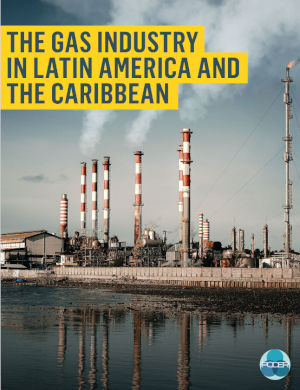The use of natural gas use is a topic of debate. On the one hand it is considered a non-renewable source the combustion of which produces almost 50% less greenhouse gases (GHG) than coal or oil combustion. So in this sense it is a relative clean burning fossil fuel according to the Energy Information Administration (EIA). At the same time, natural gas leaks are very common within hydrocarbon exploitation wells producing a strong GHG called methane. It is therefore a highly pollutant source of energy. In addition, the modern gas industry requires a great volume of water supply and land to develop the value chain. Where there is no supply chain, some oil producers prevent accidents by burning the gas leaks at well sites (gas flaring), affecting the environment and the communities surrounding these projects.
Industry developers and the owners and managers of gas reserves, along with financial institutions are implementing an international agenda to promote natural gas production to become the keystone for energy transition.
For some countries in the Latin America and the Caribbean region (LAC), natural gas is a strategic resource for obtaining revenues or promoting foreign investment. For multinational companies, it is a strategic resource to maintain long-term business, but it requires high safety standards and technological advances in order to make this, a profitable transition.
Only four countries in the region have large exporter status (Argentina, Bolivia, Trinidad& Tobago and Venezuela). The largest importer is Mexico which buys natural gas from the U.S. These trends are reflected in the number of pipelines built across the continent. More than a regional integration, they constitute a distribution network to supply all the reserves available for electricity generation and industrial purposes.
Despite the Covid-19 pandemic restrictions, natural gas consumption increased across the region with the exception of Colombia. There was also the impact, albeit minor, caused by the war in Ukraine which was reflected in international prices of oil and gas. In the long-term this impact will likely be higher for those non-producer countries.
There is a particular concern about natural gas production within national oil companies due to the low amounts compared to multinational companies’ standards. This is reflected in countries’ low level of interest in developing technological capacities to transform gas into electricity, with the exception of Mexico and Brazil, where the SOE’s capacities are the largest in LAC.
The private companies became principal actors in production and transformation via gas power plants. Twenty-three private projects hold 76% of the region’s total capacity. There is also a trending in public-private joint ventures to exploit, transform and distribute gas, derivatives and electricity.
In this debate, the perspectives from social and community stakeholders are lacking. Civil society organizations’ capacities on the issues are still developing and civic space in the region is shrinking for human rights advocacy and territorial and environmental defenders. There is an urgent need to develop the space and narrative for a “just energy transition”.

